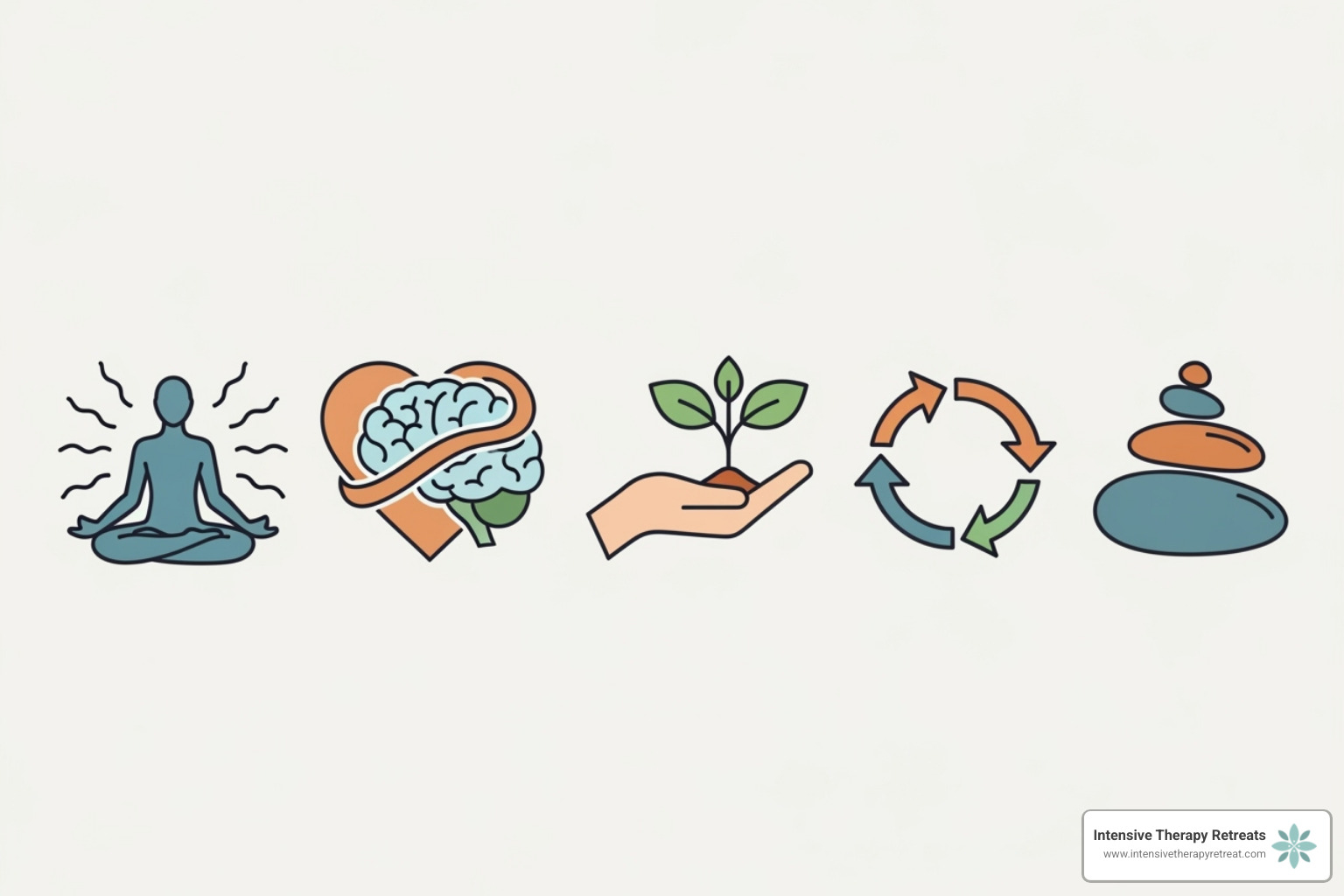The Revolutionary Integration of Mind and Body in Trauma Healing
Somatic internal family systems therapy is a groundbreaking approach that bridges talk therapy and body-based healing. It combines the Internal Family Systems (IFS) framework with somatic practices—conscious breathing, mindful movement, and attuned touch—to create deeper, more lasting change.
This therapy recognizes that trauma and emotional distress are stored in both the mind and body. While traditional IFS views the mind as a system of “parts” (protectors, exiles, etc.) led by a core Self, Somatic IFS acknowledges these parts are also held in our physical selves. It uses five core practices to help clients access their Self and heal internal parts, proving especially effective for trauma, anxiety, and chronic illness.
As developer Susan McConnell says, “The unity of body and mind is more than a concept. It is a lived experience…” This body-centered approach is for trauma survivors, as it provides tools to access and heal wounds stored pre-verbally or non-cognitively through the body’s wisdom.
I’m Bambi Rattner, Psy.D. In my decades of clinical practice and work with intensive trauma retreats, I’ve seen somatic internal family systems therapy open up healing that talk therapy alone cannot reach by honoring both the psychological and somatic dimensions of our inner parts.
Terms related to somatic internal family systems therapy:
From Theory to Feeling: Understanding Somatic IFS
Somatic internal family systems therapy unites mind and body, creating space for deeper healing. Your thoughts and feelings don’t just exist in your head—they live in your shoulders, chest, and belly. The Internal Family Systems (IFS) model teaches that we are all naturally multiple, with an inner world of various parts. Some parts protect us, some carry wounds, and all are guided by a wise core Self that knows how to heal.
Somatic IFS takes this further by recognizing that these parts live in our bodies. A knot in your stomach when anxious is likely a protective part. A caved-in chest when feeling rejected might be a wounded part holding old pain. Somatic therapy principles teach us to listen to these physical signals with curiosity, opening new pathways for healing. This mind-body connection is a lived experience that can transform how we relate to ourselves.
How Somatic IFS Expands Traditional IFS
While valuable, traditional talk therapy has its limits, especially with stored trauma or pre-verbal experiences that occurred before we had language. Responses like feeling terror when a voice is raised, or going rigid during a hug, often come from parts holding non-verbal memories that bypass the thinking mind.
Somatic internal family systems therapy views the body as a resource holding incredible wisdom. When a part can’t find words, it might speak through chronic tension or physical impulses. This approach moves us from just cognition to embodiment. Instead of only thinking about our parts, we learn to feel them, breathe with them, and allow them to express what they need physically.
The Evolution of Somatic IFS
The development of somatic internal family systems therapy emerged from the clinical recognition that true healing requires both psychological understanding and physical integration. This synthesis of bodywork and psychotherapy represents a significant advancement in trauma therapy, born from observing that lasting change required working directly with how parts were held in the body.
The development of core somatic practices—like conscious breathing and mindful movement—provides concrete ways to work with parts that might otherwise remain stuck. These advancements in mind-body healing honor the intelligence of both mind and body, recognizing that our parts need to be felt and witnessed to release their physical burdens. This is especially transformative for those whose trauma was too overwhelming to process consciously at the time.
The Five Core Practices of Somatic Internal Family Systems Therapy
At the heart of somatic internal family systems therapy are five essential practices that work together to connect you with your body’s wisdom. These aren’t mechanical techniques but living ways of being that open new doorways to healing, especially for wounds talk therapy can’t reach. The five core practices are Somatic Awareness, Conscious Breathing, Radical Resonance, Mindful Movement, and Attuned Touch. They build on each other to cultivate embodied Self energy—the calm, clear, compassionate core within you.
These somatic tools help us listen to our body’s story, as many parts express themselves through physical sensations rather than words. By using these practices, we can connect with and heal parts that might otherwise remain hidden.
Somatic Awareness and Conscious Breathing
Somatic awareness is the foundation of this work. It’s the practice of truly being in your body and listening to its messages. This means noticing the tightness in your shoulders when stressed or the clench in your stomach when anxious. These aren’t random reactions; they are your parts communicating. By welcoming these sensations with curiosity, you gain valuable information. That knot in your stomach might be a protector warning you, while tension in your jaw could be a part holding old anger.
Conscious breathing is a powerful tool that works with somatic awareness to regulate your nervous system. Your breath is always available as a bridge between your inner world and physical experience. By breathing consciously, you create a pathway for parts to unburden themselves. This might mean breathing into areas of tension to help them soften or using the breath to bring forgotten parts back into awareness. The body remembers everything, and conscious breathing helps us access those memories gently.
For a deeper understanding of how these practices connect with the broader framework of parts work, you might find it helpful to explore More on Parts Work: IFS Therapy Approach.
Radical Resonance, Mindful Movement, and Attuned Touch
The other three practices take us deeper into non-verbal healing and connection.
Radical resonance describes the vibrational attunement between therapist and client. It emerges when the therapist listens with their entire body, creating a profound sense of being seen and understood beyond words.
Mindful movement invites your body to express what it needs. Trauma can freeze us in protective patterns. This practice allows parts to complete interrupted actions or express stored emotions through spontaneous gestures. It’s not about a specific routine but about allowing your body’s wisdom to emerge, whether that’s pushing something away or curling up for comfort. This can help re-embody early developmental patterns disrupted by trauma.
Attuned touch, our first language, can be incredibly healing when applied with clear consent and ethical boundaries. It can be as simple as placing a hand on your heart to comfort a part. The key is that the touch communicates the presence of your core Self, building trust between you and your parts. It helps them release physical burdens and find their way back into a healthy relationship with your internal system.
The Healing Journey: Applications and Benefits
The journey through somatic internal family systems therapy opens the door to transformative, holistic healing. As you learn to listen to your body and develop a compassionate relationship with your internal parts, you’ll notice increased self-awareness of both your emotions and your body’s subtle communications. This awareness is the foundation for gentle yet powerful personal growth.
A key benefit is developing genuine stress resilience. Instead of being overwhelmed by challenges, you learn to regulate your nervous system and respond from a place of calm clarity. Your body becomes a trusted ally and a source of wisdom.
Applying Somatic Internal Family Systems Therapy for Trauma and Anxiety
This therapy is profoundly effective for healing trauma and anxiety, as these conditions live in our bodies as much as our minds. When something overwhelming occurs, our nervous system can get stuck in fight, flight, or freeze responses, which persist as chronic tension, digestive issues, or a constant feeling of being on edge.
Somatic internal family systems therapy offers a gentle way to work with trauma stored in the body. Through practices like conscious breathing, we help the nervous system remember safety and release physical tension. This approach is also effective for chronic illness where emotional burdens may contribute to physical symptoms. For those with attachment disorders, it helps create a felt sense of safety within one’s own body, which becomes the foundation for healthier external relationships.
You can learn more about trauma healing through The Power of Internal Family Systems (IFS) to Steer Trauma and explore how this approach helps with various mental health conditions that IFS can help with.
What to Expect in a Session: The Client and Therapist Role
A somatic internal family systems therapy session is a space of safe exploration, free of judgment. It typically begins with a gentle check-in or body scan to notice what’s happening in your body.
The collaborative process unfolds from there. Your therapist acts as a compassionate guide, attuned to your words, breath, and posture. They might ask, “Where do you feel that in your body?” You may engage in guided meditation or mindful movement to allow parts to express themselves. The explorative dialogue focuses on trusting your body’s wisdom rather than mental analysis.
Your therapist serves as a witness, helping you stay present and compassionate. The goal isn’t to eliminate difficult feelings but to develop a loving relationship with all parts of yourself by witnessing parts without judgment, which naturally allows you to access more of your core Self.
Achieving Wholeness: Embodied Self and Lasting Growth
The journey through somatic internal family systems therapy leads to a lived experience of wholeness where mind and body work in harmony. When you achieve embodied Self energy, you are living from your core Self. This is often felt as a warm, spacious sensation—a sense of coming home to yourself.
This embodied Self naturally expresses the 8 Cs of Self: Confidence, Calm, Compassion, Courage, Creativity, Clarity, Curiosity, and Connectedness. These qualities emerge organically as your parts feel safe and valued. The goal is not to eliminate parts but to restore your Self to leadership, creating inner harmony. This integration of mind and body is the foundation for long-term well-being.
To explore how this Self-leadership transforms daily life, visit IFS Self-Leadership.
Who is Somatic Internal Family Systems Therapy Suitable For?
This therapy offers hope for many, especially:
- Individuals with trauma, particularly when it’s held in the body more than in clear memories.
- People with chronic pain or illness where emotional burdens may be a factor.
- Those who feel “stuck” in talk therapy, understanding their patterns intellectually but unable to change them.
- Highly sensitive people who find cognitive approaches don’t fully honor their rich inner world of sensation.
- Anyone seeking deeper self-connection and a feeling of being at home in their own skin.
Potential Challenges and Considerations
This work requires courage and patience. Key considerations include:
- Intense Physical Sensations: Working with the body can feel overwhelming at first. Protector parts may resist this exploration.
- Pacing: The work must be paced according to your body’s wisdom. A skilled therapist will never rush the process.
- Building Trust with Protectors: These parts have worked hard to keep you safe and need to learn that somatic exploration is not a threat.
- Pre-verbal Trauma: Accessing this can feel disorienting as it bypasses the thinking mind. This is why working with a trained therapist is essential for safety and grounding.
- Professional Guidance: While basic awareness practices can be done alone, deep trauma work requires a professional to provide the safety and attunement needed for profound change.
Frequently Asked Questions about Somatic IFS
How do I find a therapist trained in Somatic IFS?
Finding a qualified therapist is a key step. A great starting point is the official IFS Institute directory, where you can find certified therapists, many with somatic training. On platforms like Psychology Today, filter your search for therapists specializing in both IFS and somatic therapy.
When you connect with a potential therapist, ask about their credentials. Inquire about their specific training in somatic internal family systems therapy, such as completion of Susan McConnell’s programs or other relevant certifications (e.g., Somatic Experiencing, Hakomi). Look for a Certified IFS Therapist with a background in body-based work. Most importantly, find someone with whom you feel a sense of safety and rapport, as this trust is essential for somatic healing.
What is the main goal of achieving “Embodied Self”?
The primary goal is to feel your core Self as a living, breathing presence in your body, not just as an intellectual concept. Accessing the core Self in this way allows you to consistently connect with your innate wisdom and healing capacity. When you are leading from a place of calm, clarity, and compassion, you respond to life’s challenges from a centered place rather than from reactive parts.
This embodied presence creates the ideal conditions for healing wounded parts, as they can finally release their burdens when they feel the steady, compassionate presence of your Self. The ultimate result is harmonizing the internal system so you can live authentically with a profound sense of wholeness and resilience.
Can I practice Somatic IFS techniques on my own?
Yes and no. You can safely practice foundational techniques on your own. These include:
- Somatic Awareness: Regularly checking in with your body to notice sensations without judgment.
- Conscious Breathing: Paying attention to your breath and using it to calm your nervous system.
- Mindful Movement: Gently stretching or moving in ways that feel intuitive and good for your body.
Many self-led exercises in workbooks or guided meditations can help you explore your internal world. However, professional guidance is crucial when dealing with complex trauma or highly activated parts. A trained therapist provides the safety and expertise needed to steer intense emotions and physical sensations that can arise. If you encounter overwhelming responses during self-practice, it is a sign that you would benefit from professional support to continue your healing journey safely.
Begin Your Journey to Embodied Healing
The path to healing doesn’t have to take years. Somatic internal family systems therapy offers a way to access profound change by honoring your mind and body as partners. Through its core practices, this approach creates lasting change that goes deeper than talk therapy alone by helping you experience your core Self as a living presence.
Mind-body integration is the key. Your body holds your story, and this therapy gives you the tools to listen and respond with the self-compassion and wholeness your parts have been waiting for. When your parts trust that your Self is present in your body, they can release their burdens and find their healthy roles, allowing you to lead from a place of calm, clarity, and compassion.
If you are ready for this kind of change, you don’t have to wait. Our Intensive Therapy Retreats create the ideal conditions for deep healing to happen quickly. In an immersive, supportive environment, you can achieve lasting breakthroughs.
Explore our immersive IFS Therapy Retreats and find what’s possible when you give yourself the gift of focused healing. Your journey to embodied wholeness can begin today.



